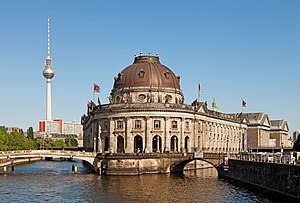By 2007 the Berlin State Museums had grown into the largest complex of museums in Europe, comprising seventeen museums in five clusters, several Research Institutes, libraries, and supporting facilities. Where in Germany is Museum Island MAP. Book accommodation near Museum Island or use the search box below.
Berlin agreed Wednesday to build a new museum for 20th century masterpieces by artists including Rothko, Magritte and Dali donated by a wealthy couple, potentially resolving a years-long dispute. The … Continue reading →
 Museum Island
Museum IslandMuseum Island ( German: Museumsinsel) is the name of the northern half of an island in the Spree river in the central Mitte district of Berlin, Germany, the site of the old city of Cölln. It is so called for the complex of five internationally significant museums, all part of the Berlin State Museums, that occupy the island’s northern part: In 1999, the museum complex was added to the UNESCO list of World Heritage Sites. A first exhibition hall was erected in 1797 at the suggestion of the archaeologist Aloys Hirt. In 1822, Schinkel designed the plans for the Altes Museum to house the royal Antikensammlung, the arrangement of the collection was overseen by Wilhelm von Humboldt. The island, originally a residential area, was dedicated to “art and science” by King Frederick William IV of Prussia in 1841. Further extended under succeeding Prussian kings, the museum’s collections of art and archeology were turned into a public foundation after 1918. They are today maintained by the Berlin State Museums branch of the Prussian Cultural Heritage Foundation. Museum Island further comprises the Lustgarten park and the Berlin Cathedral. Between the Bode and Pergamon Museums it is crossed by the Stadtbahn railway viaduct. The adjacent territory to the south is the site of the former Stadtschloss and the Palace of the Republic. The Prussian collections became separated during the Cold War during the division of the city, but were reunited after German reunification, except for the art and artefacts removed after World War II by Allied troops and not yet returned; these include the Priam’s Treasure, also called the gold of Troy , excavated by Heinrich Schliemann in 1873, then smuggled out of Turkey to Berlin and today kept at the Pushkin Museum in Moscow. As for the city’s major museums, it took much of the 1990s for a consensus to emerge that Museum Island’s buildings should be restored and modernized, with General Director Wolf-Dieter Dube’s cautious plan for their use finally approved in January 1999. Then, six months later, Peter-Klaus Schuster took over and set in motion a far more ambitious program intended to turn Museum Island into a Louvre on the Spree. The federal government pledged $20 million a year through 2010 for projects to enhance Berlin’s prestige and Unesco declaring the island a World Heritage Site. The contents of the museums were decided on as follows: The Pergamon, with the Greek altar that gives it its name, retained much of its collection and was defined as a museum of ancient architecture. The Neues Museum presented archaeological objects as well as Egyptian and Etruscan sculptures, including the renowned bust of Queen Nefertiti. The Altes Museum, the oldest on the island, displayed Greek and Roman art objects on its first floor and hold exhibitions on its second floor. The Bode Museum’s paintings went from Late Byzantine to 1800. And, as now, the Alte Nationalgalerie will cover the 19th century.



